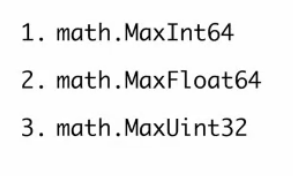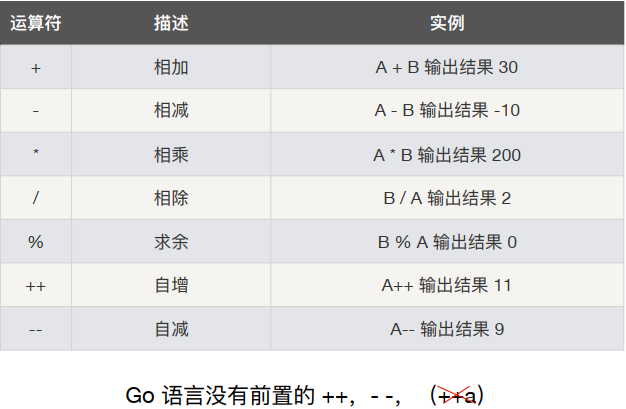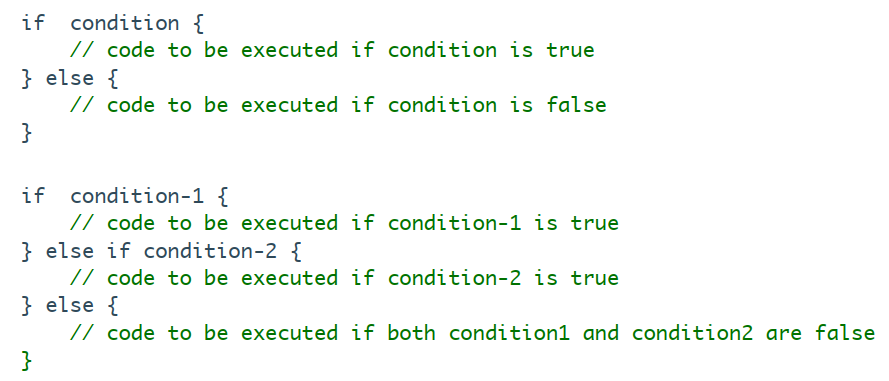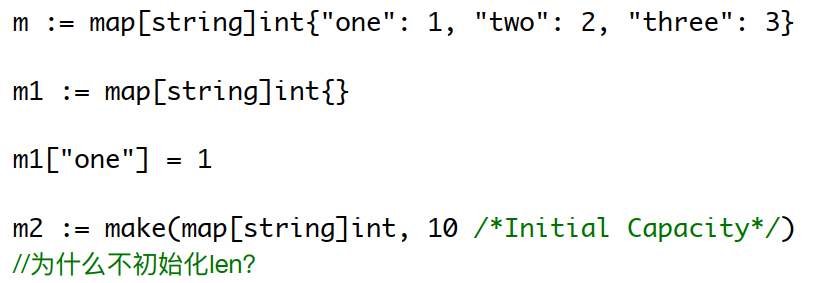一、第一个程序
基本程序结构
package main // 包 import "fmt" // 引入依赖代码
// 功能实现
func main() { fmt.Println("hello world!") }
注意点:
1.应用程序入口
- 必须是main包:package main
- 必须是main方法:func main()
- 文件名不一定是main.go
2.退出返回值
与其他主要编程语言的差异
- Go中main函数不支持任何返回值
- 通过os.Exit来返回状态
3.获取命令行参数
main函数不支持传入参数
func main()
在程序中直接通过os.Args获取命令行参数
编写测试文件
源码文件以_test结尾:xxx_test.go
测试方法名以Test开头:func TestXXX(t *testing.T){...}
package try_test import "testing" func TestFirstTry(t *testing.T) { t.Log("My first try!") }
结果
=== RUN TestFirstTry --- PASS: TestFirstTry (0.00s) first_test.go:7: My first try! PASS
Fibonacci数列
package try import ( "fmt" "testing" ) func TestFibList(t *testing.T) { var a int = 1 var b int = 1 //var{ // 可以省略int,类型推断 // a int = 1 // b int = 1 //} // 类型推断,初试化 //a := 1 //b := 1 fmt.Print(a, " ") for i:=0;i<5;i++{ fmt.Print(" ", b) tmp:=a a=b b=tmp+a } fmt.Println() }
二、变量、常量、数据类型和运算符
变量赋值
与其他主要编程语言的差异
赋值可以进行自动推断
在一个赋值语句中可以对多个变量进行同时赋值
func TestExchage(t *testing.T){ a := 1 b := 1 //tmp := a //a = b //b = tmp a, b= b, a t.Log(a, b) }
常量定义
与其他主要编程语言的差异
快速设置连续值
const ( Monday = iota + 1 Tuesday Wednesday Thrusday Friday Saturday Sunday ) const ( Open = 1 << iota Close Pending )
例子
package _const import "testing" const ( Monday = iota + 1 Tuesday Wednesday ) const( Readable = 1<<iota Writable Executable ) func TestConstantTry(t *testing.T) { t.Log(Monday, Tuesday, Wednesday) } // 1,2,3 func TestConstantTry1(t *testing.T) { a := 7 // 0111 t.Log(a&Readable==Readable, a&Writable==Writable, a&Executable==Executable) } // true,true,true
数据类型
基本数据类型

类型转化
与其他主要编程语言的差异
1.Go语言不允许隐式类型转换
2.别名和原有类型也不能进行隐式类型转换
package type_test import "testing" type MyInt int64 func TestImplict(t *testing.T) { var a int = 1 var b int64 //b = a // 不支持隐式类型转换 b = int64(a) t.Log(a, b) var c MyInt // c = b // 别名的隐式类型转换也不支持 c = MyInt(b) t.Log(a, b, c) }
类型的预定义值

指针类型
与其他主要编程语言的差异
1.不支持指针运算
func TestPoint(t *testing.T) { a := 1 aPtr := &a t.Log(a, aPtr) t.Logf("%T %T", a, aPtr) //aPtr = aPtr + 1 // 出错,不支持指针运算 }
结果
=== RUN TestPoint
--- PASS: TestPoint (0.00s)
type_test.go:22: 1 0xc04205e290
type_test.go:23: int *int
PASS
2.string是值类型,其默认初试化值为空字符串,而不是nil
func TestString(t *testing.T) { var s string t.Log("*"+s+"*") t.Log(len(s)) } 结果 === RUN TestString --- PASS: TestString (0.00s) type_test.go:29: ** type_test.go:30: 0 PASS
运算符
算术运算符

比较运算符

用==比较数组
- 相同维数且含有相同个数元素的数组才可以比较
- 每个元素都相同的才相等
逻辑运算符

位运算符

与其他主要编程语言的差异

三、编写结构化程序
循环
和其他主要编程语言的差异

示例

实例
func TestWhileLoop(t *testing.T) { n := 0 for n < 5{ t.Log(n) n++ } } 结果 === RUN TestWhileLoop --- PASS: TestWhileLoop (0.00s) type_test.go:36: 0 type_test.go:36: 1 type_test.go:36: 2 type_test.go:36: 3 type_test.go:36: 4 PASS
if条件

与其他编程语言的差异
- condition表达式结果必须为布尔值
- 支持变量赋值
if var declaration; condition { // code to be executed if condition is true }
func TestIfMultiSec(t *testing.T) { if a := 1 == 1;a { t.Log("1==1") } } // a是true,所以执行括号里内容 结果 === RUN TestIfMultiSec --- PASS: TestIfMultiSec (0.00s) type_test.go:43: 1==1 PASS
switch条件

与其他主要编程语言的差异
- 条件表达式不限制为常量或整数
- 单个case中,可以出现多个结果选项,使用逗号分隔
- 与C等规则相反,Go语言不需要用break来明确退出一个case
- 可以不设定switch之后的条件表达式,在此情况下,整个switch结构与多个if...else...的逻辑作用等同
可以有多个选项
func TestSwitchMultiCase(t *testing.T) { for i := 0; i < 5; i++{ switch i { case 0, 2: t.Log("Even") case 1,3: t.Log("Odd") default: t.Log("It is not 0-3") } } }
相当于if...else...使用
func TestSwitchCaseCondition(t *testing.T) { for i := 0; i < 5; i++ { switch { case i%2 == 0: t.Log("Even") case i%2 == 1: t.Log("Odd") default: t.Log("unknow") } } }
四、数组和切片
数组的声明

数组元素遍历
与其他主要编程语言的差异

数组截取

切片内部结构

切片声明

切片共享存储结构

数组vs切片
- 容量是否可伸缩
- 是否可以进行比较
五、Map
Map声明

Map元素访问
与其他主要编程语言的差异

Map遍历
Map与工厂模式
- Map的value可以是一个方法
- 与Go的Dock type接口方式一起,可以方便实现单一方法对象的工厂模式
实现Set

六、字符串
与其他主要编程语言的差异

Unicode UTF8

编码与存储

常用字符串函数
---恢复内容结束---

